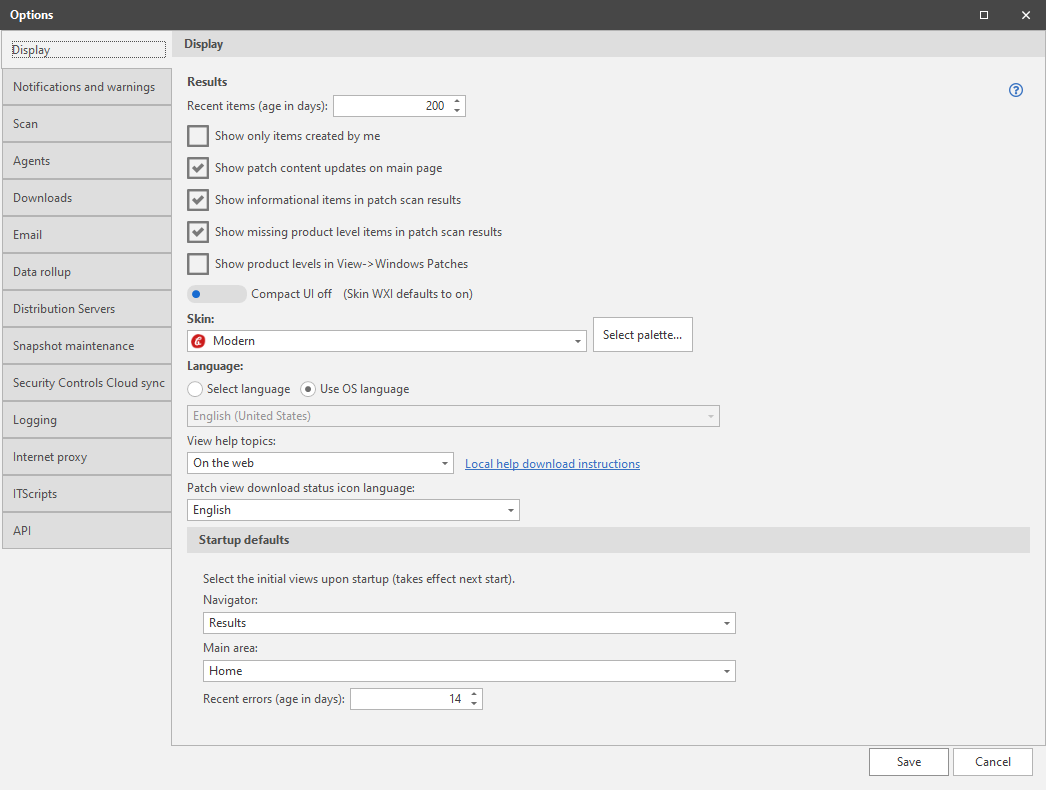Display Options
The Display Options dialog allows you to specify the optional items you want displayed in the program.
|
Field |
Description |
|---|---|
|
Recent Items |
Specifies how many days' worth of scans and deployments to show in the Results list in the navigation pane. It also defines how many days' worth of recent patch deployments to show in Deployment Tracker. The default value is 200 days. |
|
Show only items created by me |
If enabled, shows only those scans and templates that have been created by the current user. |
|
Show patch content updates on main page |
If enabled, displays the date that the patch content was last updated. The date is displayed in the upper-right corner of the interface. If you click the date the Patch Content Update Details dialog is displayed. Use this dialog to view more detailed information about the current patch data and about previous patch data releases. For more information, see Navigating the Interface. |
|
Show informational items in patch scan results |
If enabled, displays informational items on the Patches tab in Scan View and Machine View. |
|
Show missing product level items in patch scan results |
If enabled, displays missing product level items on the Patches tab in Scan View and Machine View. |
|
Show product levels in View > Windows Patches |
If enabled, displays product levels in Patch View. Product levels (1803, TH2, SP1, etc.) are by default filtered out from the content displayed in Patch View. This is because product levels are typically not needed in this view; they cannot be added to patch groups and you cannot view detailed information about product levels like you can for patches. The most common reason to display product levels in Patch View is so you can download them in advance of a deployment. |
|
Compact UI on/off |
If enabled, reduces the amount of space used to display items in the user interface. |
|
Skin |
Specifies the color theme you want to use for the Security Controls interface. If you make a change, the new skin is temporarily applied to the interface so that you can determine if you like it. To make the change permanent, click Save; to revert to the original selection, click Cancel. |
|
Language |
Specifies the language that will be used within the Security Controls interface. You have two options:
|
|
View help topics |
Specifies how to view Security Controls help topics.
If you choose Local help viewer, be sure to click Local help download instructions to learn how to manually download and configure the .chm file. The .chm file is not automatically provided with the product.
|
|
Patch view download status indicator language |
Click the drop-down list and select the language that will be represented by the download status indicator located in the top pane of Patch View. If you select the Universal Installer option, it represents the universal patch package file that can be used by all languages. For example, assume you select German in this field. If you then go to Patch View and the download status indicator for a particular patch looks like this For more information, see How to Download Different Language Versions of a Patch. |
|
Navigator |
Specifies which program feature to use as the default in the navigation pane when the program is started. |
|
Main area |
Specifies what to display in the right pane when the program is started. |
|
Recent errors (age in days) |
Specifies how many days' worth of errors to show on the home page. |
